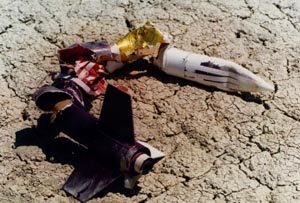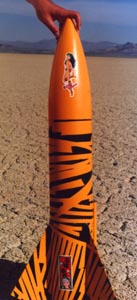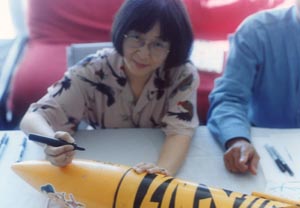
| Level One Certification |  |
||
|
I confirmed on Level One at the Aeropac-Tripoli meet in the Blackrock Desert in July 1994. Though I've flown many high-powered rockets since, I have vivid memories of that meet. We rented a Jeep Grand Cherokee and loaded up everything on Thursday night. Canopy, water, ice chest, food, rockets, motors (coals to Newcastle), clothes, maps, tapes, and tables and chairs, range boxes--in fact, everything that might be needed, ever used, or could be used. Too much stuff it seemed. Of course, we even brought our crude homebuilt launch system, just in case. I wanted to leave on Friday morning, to get to Blackrock in time to help set up, but I had to work until 1:15 that day: damn. We left our home in the San Francisco Bay Area on Friday afternoon around 3:00 P.M. My lovely wife, Carolyn, and my brother-in-law and flying partner, Brian, were fellow crewmembers on the adventure to Gerlac, Nevada. We plowed over the mountains on through to Fernley, Nevada, and hung a left onto a small two-lane highway into Nowheresville. About 78 miles later we were at mighty Gerlac just as the sun set. We were instructed by friends to register at Bruno's Bar, Casino, and Coffeeshop. Bruno, a nice Italian man in his sixties, asked me to find my own name and reservation on a large manila card--no Holiday Inn, this. Our room was laughable, with one smallish bed and no air conditioning (switched off at night). We heard other rocketeers complaining, too, but realized that it did no good, we were in the middle of nowhere. But soon the charm of the place (dirt parking lot and all) took over. We were surrounded by fellow maniacs, all in tiny rooms, doors to the hallway left wide open as they fussed over motors and spread their gear on every available surface. Rocket Heaven! We headed back to the bar "casino," which had about a dozen slots and video poker machines. Over the pool table was a sign that let us know we were now in rocket country: an Aerotech Arcus that was a little (a lot) beat up and autographed by a rocketeer in April 1990. Like an oldtime western bar in the movies, this definitely made me feel I was in the company of like-minded outlaws. I asked around and was pointed toward my quarry, Ross from Magnum. We introduced ourselves to him, joked around a little about the BATF, and made sure we had plenty of motors lined up for the next day. We talked awhile with other rocketeers, including Pius Morizumi, the prefecture leader. Then we went to bed and tried to sleep. Sleep was almost impossible because of the Union Pacific railroad, located across the street, and the rocketeers who kept arriving as the night wore on toward day. Plus I was totally excited, like I was a kid at Christmas or something. After about an hour of sleep, we got up around 5:00 A.M. and started our date with destiny . . . At 6:00 A.M. we headed for breakfast at Bruno's Cafe. After a meal of steak and eggs I was ready to get out to the desert and confirm. Not yet having a Tripoli card, I planned to register at the launch site. We piled into the Jeep and headed for parts unknown. The site itself was about 11 miles north of Gerlac on an ancient dry lakebed. I thought I had seen flat before, but I was wrong. Anywhere off the road in any direction offered more flat land than I was accustomed to fly on. There was gypsum-encrusted flat plain, seemingly lifeless, nearly as far as the eye could see, in every direction, rimmed with bluish foothills in the distant distance. We pulled off the road and headed the Jeep out toward the center of the "lake" going about 85-90 MPH. It seemed like we were flying in a small airplane. The Jeep raised a white gypsum dust trail that plumed behind us for about a half mile. We could close our eyes and drive without hitting a thing: no rocks, no plants, no wildlife--nothing but parched, cracked, saltpan. We finally approached a line of tents in the desert and pulled to a stop at the western end of the line. Out we popped to set up our canopy; because we had sort of practiced once before (but didn't succeed in getting it up), we had it assembled in about 20 minutes. Carolyn started taking pictures, to document our every move, and we waited in line at Ross's Magnum truck, the only supplier to make it to the launch. His large truck was an eyeful! Brian and I got two Vulcan H-125s, to certify on Loc Hi-45s. Brian launched first and quickly got success: a fine, no-nonsense flight with perfect deployment. His witness for Level One Certification was Pius Morizumi. I launched on the next rack with my Loc Hi-45, and . . . perfect blastoff, but ohhh, what a sick feeling in the pit of my gut when the deployment charge failed to go off. The Hi-45 nosed straight down into the hard pan. Not much left of it. How humiliating. (The picture at the top of this page shows the crumpled mess that was left after it impacted with the unforgiving Blackrock salt plain.) Carolyn squeezed water over my sweating brow, gave me a pep talk, and made me drink fluids. Thus fortified, I pushed forward and prepped my Loc Mini-Mag, which I had painted in a yellow-and-black tiger stripe pattern like the tiger-striped bikini worn by Lum in Rumiko Takahashi's Urusei Yatsura. |
 |
Ross sold me a Vulcan H motor, and he enhanced the ejection charge with some extra black powder. Pius Morizumi stood by to act as my witness during the second flight. I stood at the line, nervously waiting for the countdown. Man, the pressure. It felt like I was twelve years old again, struggling with one of my competition rockets. And then--whoosh! A good, medium-high boost and a shaky deployment of the parachute, but it was enough to get me confirmed at Level One. Relief! Victory! Congratulations all around! Even better, the meet wasn't over, and there were plenty more rockets to fly. |
|
Later I had the honor of getting Takahashi's signature on the rocket. But back in the desert, I had other plans. I was read to try a move up in power to a 54mm AeroTech I-65-10W. My rocket choice to fly this motor was the Loc EZI-65. I have never seen or handled such a large motor before. It was in a stainless steel casing or facing, and was sleek and fine. |
 |
|
I prepared for an altitude recorder flight, but scrubbed the attempt when I fumbled the small switch piece into the hardpan. I flew the rocket anyway, and it quickly entered an arc and flew downrange at about 3500 feet high. I headed out after it on foot and was happily surprised when Carolyn and Brian drove up behind me in the Jeep after about 15 minutes. I climbed into the Jeep and we went roaring out to the landing site--what a way to recover, just point your car into the desert and floor it to 60 MPH! We were finished for Day 1. We took down our canopy and repacked the Jeep, heads full of what we had seen (and heard! that many HPR launches really assault the eardrums). We had seen a K cato and enjoyed several serious altitude attempts by other rocketeers. A two-stage (M or O) went so incredibly high that many of us lost sight of it until the second stage kicked in. These "for real" attempts were launched mostly from pads 98 and 99, set far away in the distance. The night launch that evening was canceled due to high winds that came up late in the day after we had left the site and returned to Gerlac. Lightning was striking in the distance and moving closer. There were two forest fires to the south, up in the mountains. We went back to our room and quickly fell asleep from exhaustion, satisfied with our day's work. We woke around 7:00 A.M., and after breakfast we left for the launch site. We set up our canopy more quickly this time and found that although there were still a lot of people at the meet, there were fewer than yesterday. We started preparing the Loc EZI-65 for an altitude attempt, pushing our envelope that morning. The motor of choice was an AeroTech J-125-15W. Wow!! This was the highest power motor I had ever seen upclose, then alone flown. The motor was over 1200 newtons (I think) and had the longest delay I'd ever seen. We prepped the altimeter, and it started to beep . . . beep . . . beep. The RSO thought the J would rip the rocket's fins off, because I had only epozed three layers of fillets. But I was more confident, and he agreed to let me make the attempt. The motor smoked slightly on the pad (we were using Rocketflyte magnilite ignitors), then whoosh--another takeoff like the I motor, but more sustained-- truly crazy when it's way high up there and it still has much more to give as a motor. The deployment was at or very near apogee. Pius said that next time we should try it with an altimeter deployment, but hey, this is the most successful launch I've ever had. We head out across the saltpan to recover after following the rocket's descent. Brian walks up to it first and hears as it reports its altitude as . . . 7553 feet! A personal best record for me. We get back to the line and prepare our final two launches. Mine is a Vaughn Brothers Extreme 54mm on a 54mm AeroTech I-65-10W, and Brian's is a Loc Hi-45 on an AeroTech H-145-10W. I flew first, using the altimeter. The launch was delayed one round due to continuity problems, but this was fixed, and it was a spectacular flight, moving quickly off the pad right in front of the Vaughn Brothers' tent. They seemed to like the way I had put a killer motor in it. But after a deployment of white tracking powder and chute, the rocket was lost in the hot Nevada sun and sky. I really didn't know where it had gone, but I started walking out into the desert, not telling anyone where I was going. Like a dummy, I did not bring any water with me. We had spent money and time getting all this extra water for the trip, but hey, in a second I'll run after a rocket with no hat or water. (For sheer stupidity, it even beats the time I jumped into the San Francisco Bay to recover a rocket: just took off my clothes, handed my wallet to a stranger, slid into the chilly water in my underwear, and started swimming out toward the breakwater, heedless of the boats motoring past.) Anyway, I looked around but couldn't find the rocket, just lots of hard pan and heat. Luckily, Carolyn saved me, roaring up in the Jeep, air-conditioning blasting, after about half an hour. She thought I was with Brian, who was prepping his Hi-Tech attempt, but knowing me, she finally figured out I was probably trudging off somewhere mindlessly, in need of rescue. On the way back, we saw Brian launching his Hi-Tech. We recovered his rocket, packed up, and split back to the Bay Area around 1:00 P.M. When we got home, after hours on the freeway, the Jeep was still coated with a thick layer of Blackrock gypsum. We were still coated. The launch boxes were still coated. Everything was still coated! But we were also covered in glory--we had successfully confirmed. I later got a call from one of the Vaughn Brothers, and he said that around 1:00 someone had found my missing rocket with the altimeter beeping out 6992 feet. This was lower than the live tracking crew's report of 7062 feet, but I was happy to hear the rocket was being mailed back to me, altimeter and all. A word about our prefecture leader, Pius Morizumi. Boy did this guy work hard at providing an excellent rocket meet. His energy levels were always high and friendly. I learned a lot from him, and so did Brian. He gave us basic education in how a high-power rocket should be prepped and flown. Thanks also to Paul Campbell of Berkeley for his ongoing close support. Over the years and subsequent meets, my admiration for Pius's devotion to the rocketeering cause had only increased.
|
||